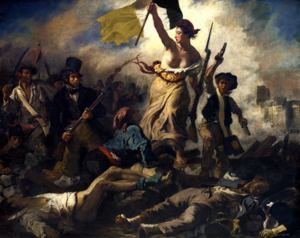February Revolution (Sunrosia)
| February Revolution | |||||||
|---|---|---|---|---|---|---|---|
| Part of the Euclean Spring | |||||||
 Mother Freedom Leading the Way by Otakar Suchanek: an allegorical painting of the February Revolution | |||||||
| |||||||
| Belligerents | |||||||
| Commanders and leaders | |||||||
| Strength | |||||||
| 10,000 | Between 30,000 and 50,000 | ||||||
| Casualties and losses | |||||||
|
| ||||||
The Sunrosian Revolution of 1856, also known as the February Revolution, was a revolution in the Sunrosian Monarchy. The revolution started as a wave of unrest throughout the Monarchy in the wake of its defeat in the War of the Triple Alliance, and culminated with a popular uprising by in the city of Coerz on 6 February leading the Grand Council of Coerz to proclaim Adalbert XVII as monarch and calling for the abdication of incumbent George VII William. After a period of seven days popularly known as the Long Week (Weranian: Die lange Woche), George VII William chose to abdicate and Adalbert XVII became the undisputed monarch of Sunrosia, signing the Constitutional Charter of 1856, marking the end of absolutism and beginning of constitutionalism in Sunrosia.
Sunrosia was devastated by the three years long War of the Triple Alliance: many campaigns took place on its soil and it suffered serious casualties both military and civilian. The Congress of Torrazza led to significant territorial losses to Werania and Estmere, despite a series of minor victories near the end of the war. The popular perception of the war being about to change tide near its end, only for Sunrosia to be defeated in the peace congress alimented resentment of the Monarchy and of George VII William personnally, commonly blamed for his conduct during the war and for his unflexible approach to governing in spite of changing conditions. Protests started to take place against imperial authority around the country, most being quelled with few if any loss of life.
Discontent was particularlly high in Coerz, the former capital city of the Monarchy before being replaced by Georgehaven, which had become a center of political opposition ever since. Angered about the Emperor's announcement that several war-time ordinances would be maintained, protests started in front of the residence of viceroy Philippe de Halban on 4 February. The protests were ordered to be quelled by the imperial Georgehaven-based government. The city's garrison use of lethal force causedthe people of Coerz to rise up in uprising and set up barricades by 6 February. They were joined by defecting military units, and by 7 February the city hall was taken. Though occurrences of fighting throughout the city continued for the next few days, Coerz had for all intents and purposes fell to revolutionaries.
A Sunrosian provisional government was set up from Grand Council of Coerz that had been established during the revolution. Primarily composed of liberals, both constitutional monarchists and republicans inspired by the ideals of the Euclean Spring, with a small but significant proportion of early socialists, the Council eventually voted on proclaiming a constitutional monarchy headed by Prince Adalbert of Windenheim-Treniotis, a member of both the Council and a cadet branch of the imperial family, and calling for the abdication of George VII William on 10 February. George initially refused, but as more and more cities declared themselves in favour of Prince Adalbert drawing the country closer to civil war, he abdicated and fled to Gaullica on 17 February, traditionally marking the end of the February Revolution.
Prince Adalbert was formally crowned as Adalbert XVII and signed the Constitutional Charter of 1856 into law within the month, officially making Sunrosia, once the bastion of enlightened absolutism, into a constitutional monarchy. Nevertheless, radical republicans and socialists disillusioned by the outcome of the revolution continued to protest and caused several uprisings, drawing both movements closer. The February Revolution has traditionally been considered a victory for revolutionary forces; this view has been challenged by sections of post-revolutionary Swetanian historiography, that consider the popular uprising to have been subverted by the interests of an alliance of the liberal bourgeoisie and moderate conservatives exemplified by their choice of Adalbert XVII, whom exact role and involvement in his own election remains a matter of debate.